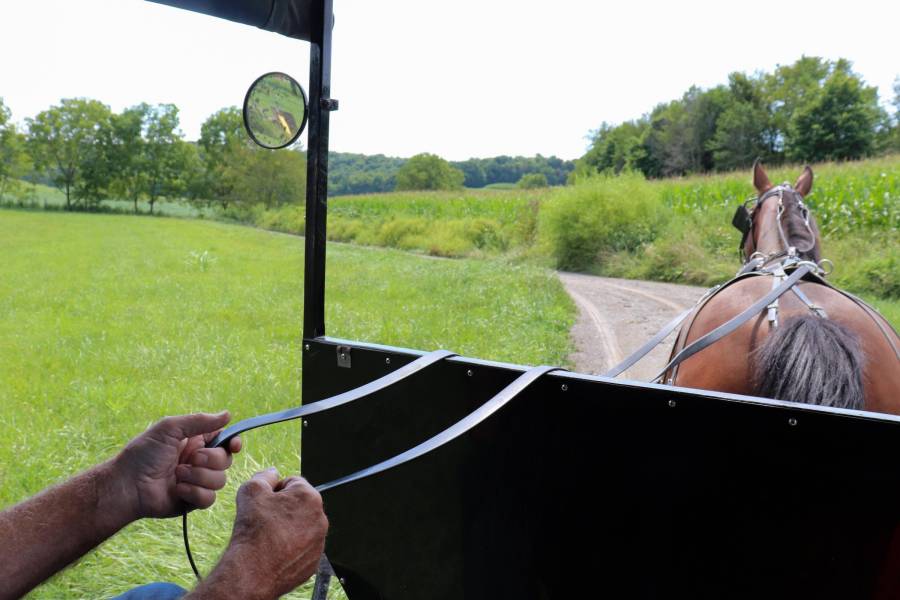
A horse and buggy drive through Holmes County, the heart of Ohio's Amish community. (Paige Pfleger/Side Effects Public Media)
Holmes County, Ohio is a patchwork of farmland. Modest houses perch on sloping hills and laundry hangs from clothes lines, flapping in the wind. There are horses and buggies – some driven by farmers in straw hats, others by women with their hair covered in bonnets, babies on their laps.
Holmes is one of the healthiest counties in Ohio. It’s also the least insured.
More than 20% of the population does not have health insurance, according to Census data. Local officials say that number is closer to 40%. That’s in large part because of the Amish population.
The Midwest is home to some of the nation's largest Amish communities, and Holmes County is one of them. It's projected to be the nation's first county where over half the population is Amish. And the Amish don’t participate in the U.S. health insurance system.
“Insurance is more for your own benefit," says Dan Yoder. "The aid plan is when all the church members get together and they try to help everybody else. Not for their own benefits."
Yoder is a member of the Amish community in Holmes. He pays all the medical bills for his church members and surrounding churches, too, using a fund that everyone contributes to. The "self-pay" program costs between $90 and $110 a month per member to participate.
“We have some exemption in promising to the state and the government that we will take care of our own people, so we don’t need the insurance,” Yoder says.

Michael Derr heads the health department in Holmes County. (Paige Pfleger/Side Effects Public Media)
The Amish community doesn't participate in Medicare or Medicaid, either. Yoder even negotiates with health providers the way an insurance company would to get lower prices for medical care. Often he can secure discounts because they pay all their bills quickly.
“Our health providers will never have a bill that is more than 10 days old,” Yoder says, “versus when the insurance company works with health providers on health care, you’re talking about eight months to a year before the providers get payment.”
Despite the lack of traditional insurance, the Amish tend to be healthier than their non-Amish neighbors, according to data from Holmes County.
“Holmes County is very proud of the fact that we’re number one in the state for our environmental factors. That’s because we use a lot of alternate means of transportation – we see a lot of bicycles, we see a lot of horse and buggy,” says Michael Derr, head of local health department.
Derr says those modes of transportation can help with a more active lifestyle and contribute less to pollution. But they also make it difficult for the Amish to reach health care providers. More than half the population goes elsewhere for care, because the rural county doesn’t offer the needed services.
“To bring in the different providers, that would take that full gamut of Medicare, Medicaid, private insurance," Derr says. "Self-pay, it’s really hard to attract those physicians into the community."

There are more than 35,000 Amish people living in Holmes County, Ohio. (Paige Pfleger/Side Effects Public Media)
There’s only one hospital in Holmes County, and it accepts all forms of insurance, including the Amish fund.
There are also nearby Amish-dedicated clinics, like the New Leaf Center. Every year, church members are asked to donate $30 to the clinic. It specializes in treating children with genetic diseases – like cystic fibrosis or Down syndrome - that are more frequent in the Amish community because of its relatively small genetic pool.
The cost of care is a common topic during exams, says Ethan Scott, a pediatrician at the New Leaf Center.
“There’s very few rooms that I walk out of that we haven’t had some discussion about what the cost and what the estimated bill to the family and the church is going to be,” he says. “So you have to be willing to be very transparent, and that is a huge contrast to most health care systems.”
Scott calls that transparency a positive part of the Amish system. But patients can struggle with the fact that money for their health care is coming out of their neighbor’s pocket, he says.
“We do see families really grapple with the burden that they’re going to potentially be with their community at large,” Scott says. “It’s pretty rare that we’ll sit down with a family here the first time and lay out treatment options and that they will consent the first time. They’ll usually tell us they need to go speak with their grandparents, maybe bishops at their church.”
He says in many cases, the church fund will raise money for expensive procedures like bone marrow transplants.
In other cases, however, the group decides the possible benefits for one patient aren’t worth the cost to the whole community. In those cases, the person goes without care.
This story was produced by Side Effects Public Media, a news collaborative covering public health.
 DONATE
DONATE





 View More Articles
View More Articles


 Support WFYI. We can't do it without you.
Support WFYI. We can't do it without you.